Related Research Articles

Kathmandu, officially Kathmandu Metropolitan City, is the capital and most populous city of Nepal with 845,767 inhabitants living in 105,649 households as of the 2021 Nepal census and 2.9 million people in its urban agglomeration. It is located in the Kathmandu Valley, a large valley in the high plateaus in central Nepal, at an altitude of 1,400 metres.

Mahendra Bir Bikram Shah Dev was King of Nepal from 13 March 1955 until his death in 1972, which was due to heart attack as told in an interview by his personal physician Dr. Mrigendra Raj Pandey. Following the 1960 coup d'état, he established the partyless Panchayat system which governed the country for 28 years until the introduction of multiparty democracy in 1990. During his reign, Nepal experienced a period of industrial, political and economic change that opened it to the rest of the world for the first time after the 104-year-long reign of the Rana rulers, who had kept the country under an isolationist policy, came to an end in 1951.

Gyanendra Bir Bikram Shah Dev is a former monarch who was the last King of Nepal, reigning from 2001 to 2008. As a child, he was briefly king from 1950 to 1951, when his grandfather, Tribhuvan, took political exile in India with the rest of his family. His second reign began after the 2001 Nepalese royal massacre. Gyanendra Shah is the first person in the history of Nepal to be king twice and the last king of the Shah dynasty of Nepal.

Licchavi was a kingdom which existed in the Kathmandu Valley, Nepal from approximately 400 to 750 CE. The Licchavi clan originated from Vaishali, and conquered Kathmandu Valley. The Licchavis were ruled by a maharaja, aided by a prime minister and other royal officials, but in practice local communities were controlled by caste councils.
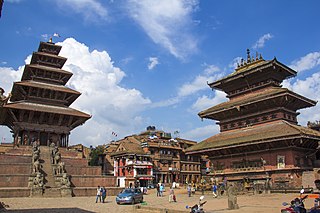
Bhaktapur, known locally as Khwopa and historically called Bhatgaon, is a city in the east corner of the Kathmandu Valley in Nepal located about 13 kilometres (8.1 mi) from the capital city, Kathmandu. Bhaktapur is the smallest city of Nepal as well the most densely populated. Along with Kathmandu and Lalitpur, Bhaktapur is one of the three main cities of the Kathmandu Valley and is a major Newar settlement of the country. The city is also known for its Newar tradition, cuisine and artisans. Bhaktapur suffered heavy damage in the April 2015 earthquake.
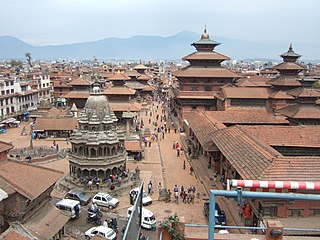
Lalitpur Metropolitan City is a Metropolitan city and fourth most populous city of Nepal with 299,843 inhabitants living in 49,044 households per 2021 census. It is located in the south-central part of Kathmandu Valley, a large valley in the high plateaus in central Nepal, at an altitude of 1,400 metres.
National Heroes of Nepal is a list of 18 Nepali people, that also includes those from ancient and medieval times, who were selected to their ranks posthumously by a commission headed by famous writer Balkrishna Sama who was appointed by King Mahendra, in 1955. The commission was directed to make nominations on the basis of their contributions to the nation, its influence and consequences. On these regards, the commission nominated people by their contributions to the pride of the nation be it in religious, cultural or economic reforms, wartime bravery, to the cause of democracy, literature, architecture.
Amshuverma or Amshu Verma was a king of Nepal from around 605–621 CE. Initially a feudal lord, he rose to the position of Mahasamanta in about 598 CE when Shivadeva I of the Licchavi dynasty was the ruling monarch and by 604, Shivadeva was reduced to a mere figurehead. He is considered to have died in 621 AD and was succeeded by Udaydeva, the son of Shivadeva I.

Nepali architecture or Nepalese architecture is a unique blend of artistic and practical considerations. Situated between the trade routes of India, Tibet and China, Nepali architecture reflects influences from these cultural strongholds. The pagoda architectural tradition figures prominently among Hindu temples in the country. In contrast, Buddhist temples reflect the Tibetan tradition of Buddhist architecture and the stupa features prominently. Mugal, summit and dome styles also have great scope in Nepal. Whilst significant influence for Nepal's architecture comes from India, there is also a distinct influence from the Newar people.
Shivraj Singh is an Indian polo player. He is the son of Gaj Singh, the King of Jodhpur.
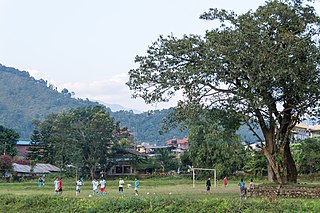
Football is one of the major and the most popular sports of Nepal. It is governed by the All Nepal Football Association (ANFA). The present acting president of ANFA is Karma Kshiring Sherpa. The current top domestic league is the Martyr's Memorial A Division league. The Nepal national football team represents Nepal in all international competitions.
Bungamati, is a settlement in Lalitpur Metropolitan Region, Ward No. 22 in Lalitpur District, Nepal. Bungamati is a Newar town on a spur of land overlooking the Bagmati River

Bhaktapur Durbar Square is a former royal palace complex located in Bhaktapur, Nepal. It housed the Malla kings of Nepal from 14th to 15th century and the kings of the Kingdom of Bhaktapur from 15th to late 18th century until the kingdom was conquered in 1769. Today, this square is recognised by UNESCO, managed jointly by the Archeological Department of Nepal and Bhaktapur Municipality, and is under heavy restoration due to the damages from the earthquake in 1934 and the recent earthquake of 2015.

Bahadur Bhawan is a Rana palace in Kathmandu, the capital of Nepal. The palace complex, located west of Jamal, north of Keshar Mahal was incorporated in an impressive and vast array of courtyards, gardens and buildings. Initially the palace was built by Bir Shumsher JBR and was rebuilt by Rudra Shumsher JBR after its destruction by fire in BS 1962.
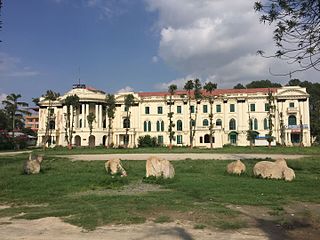

Harihar Bhawan is a Rana palace in Patan, Nepal the capital of the Nepal. The palace complex, located west of the Shree Durbar, was incorporated in an impressive and vast array of courtyards, gardens and buildings.

Dullu Palace used to be the administrative centre of Dullu Kingdom in ancient Nepal. It is located in Dailekh district of western Nepal. In April 2002 Maoist bombarded the palace. Currently, the ruins of the palace exist in the current spot. The local government is trying to find funds to renovate the palace and convert the place into a tourist attraction.
Lo Manthang Palace is a historical palace in Nepal. It is located in 3800 m above sea level in Mustang district. The palace is under consideration to be listed in UNESCO World Heritage site.
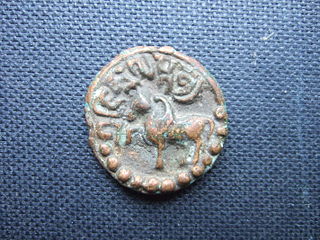
Jishnu Gupta, often spelled Jishnugupta, was a de facto ruler of Nepal in the 7th-century during the time of the Lichchhavi dynasty. Initially sharing the administrative powers with Dhruvadeva from 624 CE, he became the highest authority in the realm from around 627. He belonged to the Abhira-Gupta dynasty.
Dhruvadeva, also spelled Dhruva Deva, was a son of Shivadeva I of the Licchavi dynasty and a king of Nepal in the 7th century. He deposed his brother Udaydeva with the help of Jishnu Gupta and reigned as a figurehead monarch.
References
- ↑ "On Kailashkut Bhawan". Archived from the original on 16 February 2015. Retrieved 23 April 2015.
- ↑ "The Lichchhavi Period" . Retrieved 23 April 2015.
- ↑ Shrestha, Tulsi Narayan (2005). Nepalese Administration: A Historical Perspective. Ratna Pustak Bhandar. ISBN 978-99933-0-478-4.
- ↑ "King Amshuverma, initiator of trade and industry in Nepal" . Retrieved 23 April 2015.
- ↑ "The forgotten town of Handigaun". kathmandupost.com. Retrieved 2021-02-10.
- ↑ "Hadigaun-Maligaun area as potential Cultural tourism hub". myrepublica. Retrieved 2021-02-10.